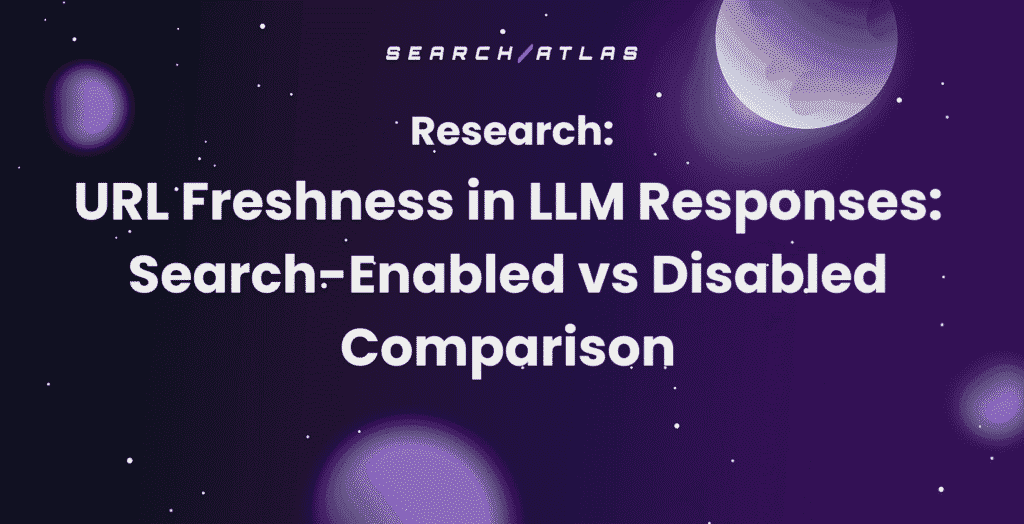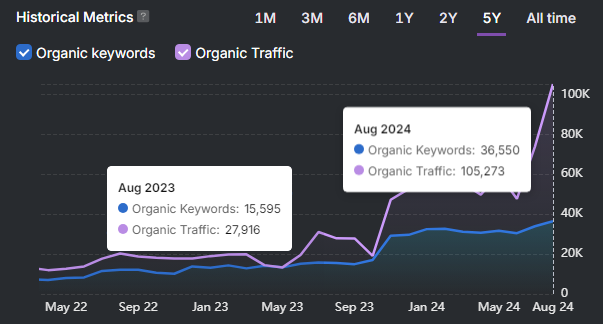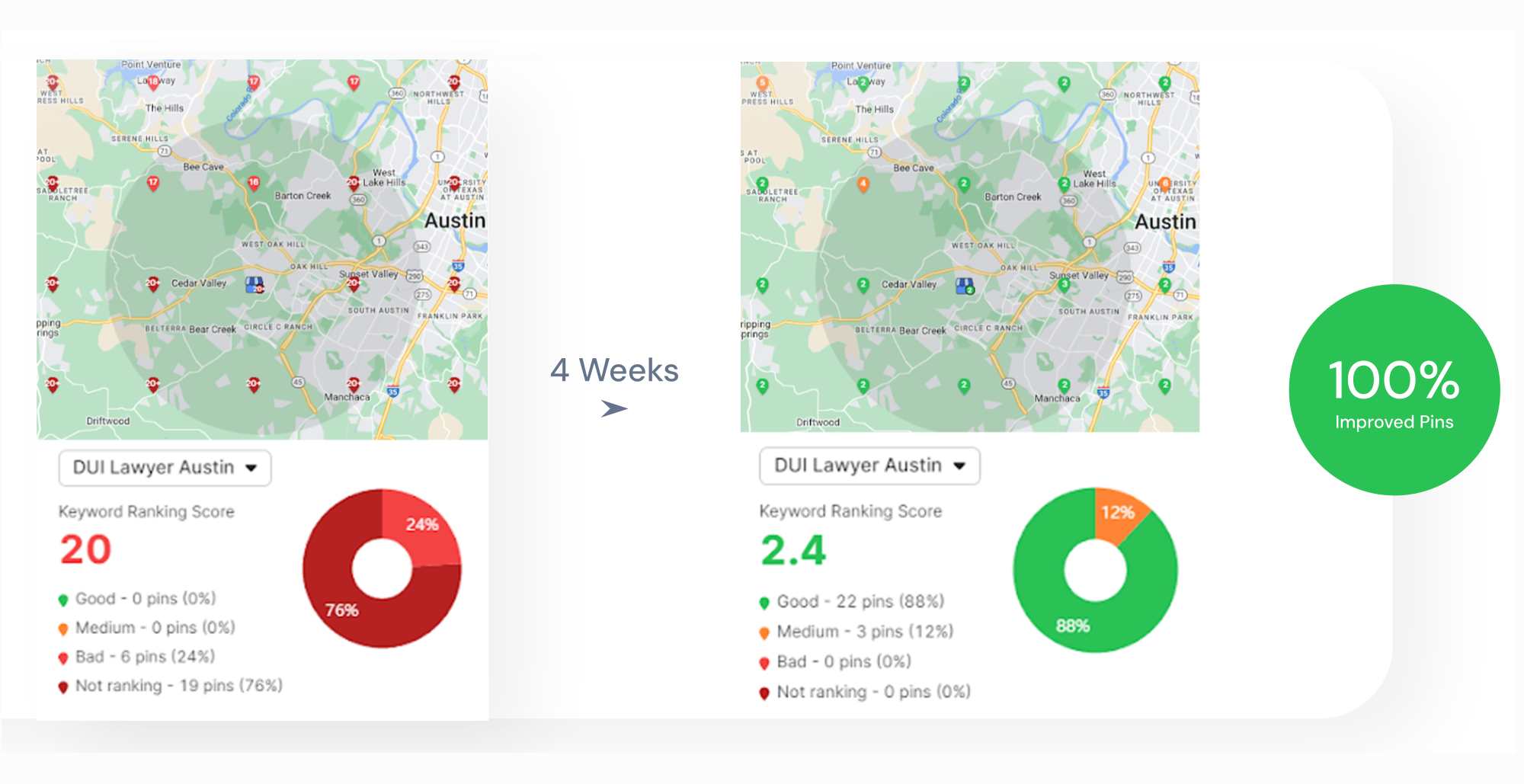SEO goals are specific, measurable targets that guide your search engine optimization efforts toward improving your website’s visibility, traffic, and overall performance. SEO goals serve as a roadmap to align your SEO activities with broader business priorities. The most common goals of SEO are increasing organic traffic, acquiring high-quality backlinks, reducing bounce rates, and optimizing engagement rates.
To set smart SEO goals and objectives, start by reviewing your business objectives, conducting an SEO audit, and performing thorough research. Then, outline your goals and define key performance indicators (KPIs) to track progress. Regularly reviewing and adjusting your SEO targets guarantees continuous improvement and alignment with changing market conditions.
What Are SEO Goals?
SEO goals are specific, measurable objectives that guide a website’s search engine optimization efforts. SEO goals define what a business aims to achieve through SEO. Effective search engine optimization goals help shape the SEO strategy and provide a clear focus for optimization activities.
The common objectives of SEO are increasing organic traffic, improving keyword rankings, increasing the quality and relevance of content, earning high-quality backlinks, and optimizing technical elements like site speed and mobile responsiveness. For example, a business might set a goal to rank on the first page of Google for specific high-intent keywords within six months. Setting clear SEO goals helps businesses measure the effectiveness of their SEO campaigns and make data-driven decisions to improve their online presence.
What is the Primary Goal of SEO?
The primary goal of SEO is to increase relevant organic traffic that converts into business value. The primary goal of SEO involves optimizing various elements of the website so that it ranks higher on search engines for relevant keywords, ultimately attracting more targeted traffic.
The main goal of SEO encompasses the elements listed below.
- Relevance. Relevance means attracting visitors who are searching for your products, services, or information, not just any traffic.
- Organic traffic. Organic traffic refers to unpaid visitors who find you naturally through search results, as opposed to paid advertising. Organic traffic creates sustainable, long-term value.
- Business conversion. Business conversion is the critical end result, whether that is making sales, generating leads, building email lists, increasing brand awareness, or achieving specific outcomes that matter to your organization.
The primary SEO marketing goal naturally aligns SEO efforts with business success. When you optimize for relevant traffic that converts, you are simultaneously improving user experience, search engine rankings, and business outcomes. Search engines want to deliver the best results to users, so websites that genuinely serve their audience’s needs tend to perform well in rankings.
What is the Importance of SEO Goals?
The importance of SEO goals lies in transforming SEO from scattered activities into a strategic, results-driven process that delivers measurable business value. SEO goals provide clear direction for optimization efforts, preventing businesses from pursuing every possible tactic without purpose. Clear SEO goals help businesses prioritize which keywords to target, what content to create, and which technical issues to fix first.
Well-defined SEO goals establish concrete benchmarks that allow businesses to track progress and demonstrate the value of SEO investments. Strategic SEO goals make sure the optimization efforts support broader business objectives rather than existing in isolation. Additionally, robust SEO goals connect search engine activities to real outcomes like lead generation, sales growth, or brand awareness, making SEO a true business driver rather than just a technical exercise.
Targeted SEO goals help businesses allocate time, budget, and effort more effectively by identifying which SEO activities will have the greatest impact on their desired outcomes. This strategic allocation prevents wasting resources on low-impact tasks and guarantees maximum efficiency in optimization efforts. Effective SEO purposes and goals create accountability by establishing what success looks like and when it should be achieved. This accountability helps teams stay focused, motivated, and responsible for delivering results rather than just completing activities.
Setting SEO goals enables strategic planning by providing milestones and targets that guide your optimization roadmap over months and years. Establishing clear SEO goals and expectations helps you build sustainable organic growth rather than seeking quick fixes that do not create lasting value for your business.
What Are the Top 10 SEO Goals?
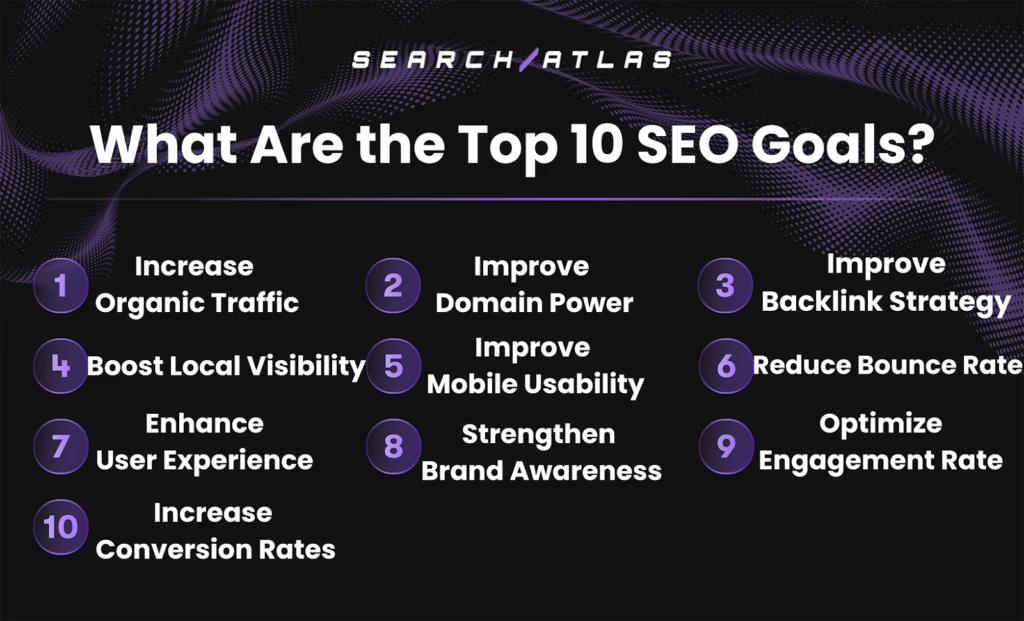
There are 10 SEO goals that businesses commonly set to boost their online presence and drive results. The top 10 SEO goals are listed below.
1. Increase Organic Traffic
Increasing organic traffic is one of the most common and fundamental goals of SEO. Increasing organic traffic refers to growing the number of visitors who reach your website through unpaid search engine results. These visitors find your site by entering queries into search engines and clicking on your naturally ranking pages. Organic traffic represents people actively seeking information, products, or services related to your business, making it particularly valuable because it demonstrates intent and interest. This type of traffic is sustainable and cost-effective since you don’t pay for each visitor, unlike paid advertising.
Organic traffic improvements are measurable through tools such as Google Analytics, Google Search Console, and the Search Atlas Site Explorer Tool. The Search Atlas Site Explorer Tool provides instant insights into organic and paid traffic, keyword rankings, backlink profiles, and more. With its intuitive, user-friendly interface, the Search Atlas Site Explorer Tool helps you easily monitor your SEO efforts, identify opportunities for improvement, and make data-driven decisions.
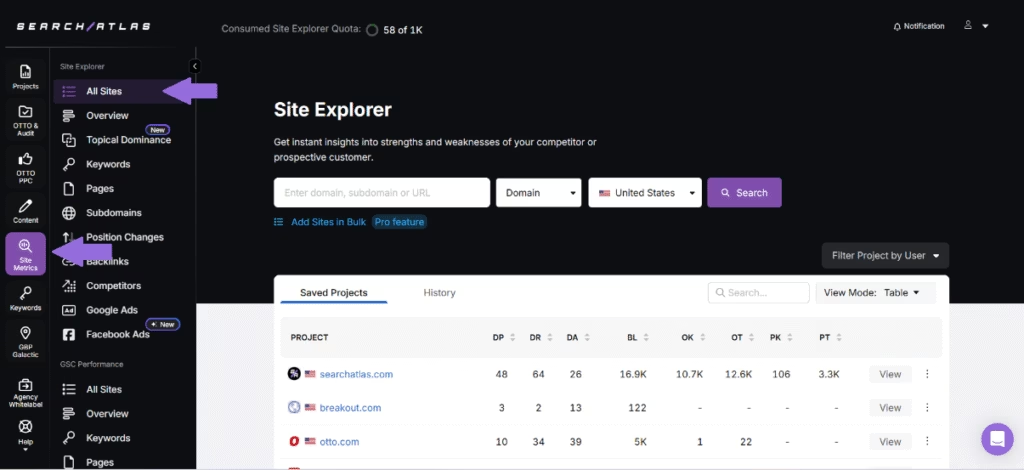
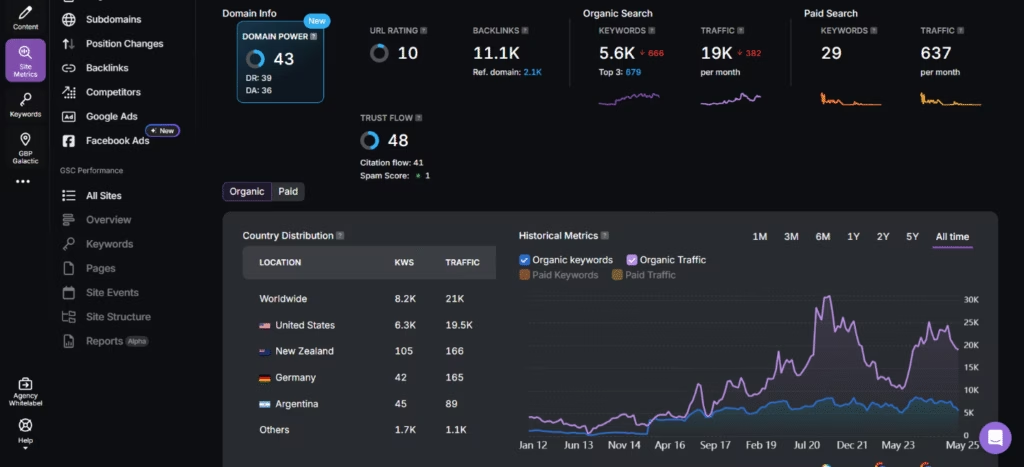
Boosting organic traffic is a highly achievable goal, although the timeline and degree of growth depend on various factors, including your starting point, competition level, and resources available. Improving organic growth is typically a gradual process that builds momentum over months rather than days, but the long-term benefits make it a worthwhile and achievable investment for most businesses.
2. Improve Domain Power
Improving domain power refers to the goal of increasing your website’s overall strength and credibility as measured by search engine optimization metrics. Domain power is a next-generation metric developed by the Search Atlas SEO Software Platform, which is emerging as the more accurate and reliable authority signal when compared to Domain Authority (DA) and Domain Rating (DR). Domain power predicts how likely a website is to rank well in search engine results pages. A higher domain power suggests that search engines view your website as more authoritative and trustworthy within your industry or niche, which can positively impact your ability to rank for competitive keywords and attract organic traffic.
Domain power improvements are measurable through tools such as the Search Atlas Site Explorer Tool. The Search Atlas Site Explorer Tool evaluates and scores a website’s authority on a scale from 1 to 100. This score reflects the site’s overall organic traffic and keyword performance relative to other websites in the database.

For larger-scale analysis, the Search Atlas Bulk URL Analyzer Tool allows users to assess the domain power of up to 5,000 URLs at once, making it a valuable resource for competitive analysis and large SEO audits.
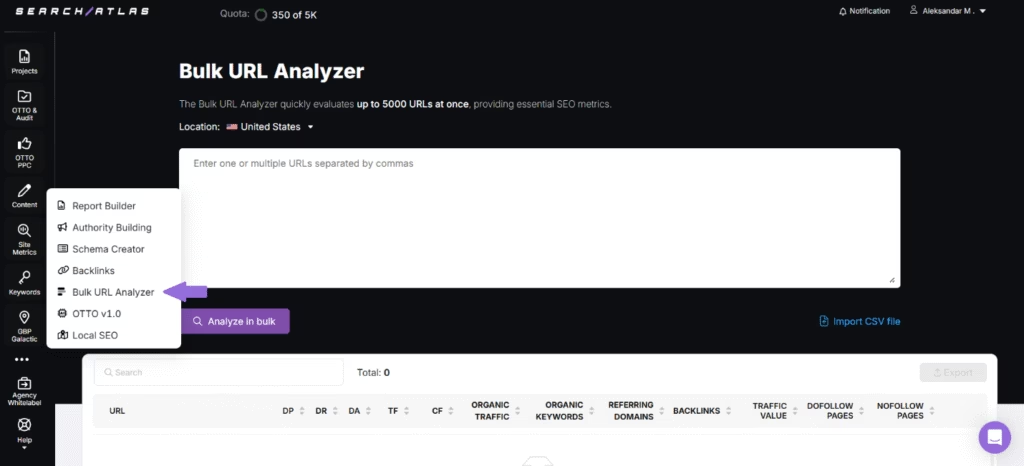
Improving domain power is achievable, but it requires sustained effort and time. The strategies to boost domain power are earning high-quality backlinks from reputable sites, creating valuable and shareable content, improving internal linking, and maintaining strong technical SEO practices. Increasing domain power does not guarantee higher rankings, but it often correlates with improved search visibility, making it a worthwhile and attainable SEO goal for long-term growth.
3. Improve Backlink Strategy
Improving backlink strategy refers to the process of improving how a website earns and manages inbound links (backlinks) from other websites. Backlinks are one of the most important ranking factors in SEO because they act as votes of confidence, signaling to search engines that your content is valuable and trustworthy. A strong backlink strategy involves acquiring high-quality, relevant links from authoritative websites, rather than simply accumulating a high quantity of links.
Backlink strategy improvements are measurable through tools such as the Search Atlas Backlink Research Tool. The Search Atlas Backlink Research Tool helps you to analyze and understand the backlink profile of any website, page, or subdomain. Additionally, the Search Atlas Backlink Research Tool identifies referring domains, linking pages, anchor text distribution, and tracks new or lost backlinks as well as potential spam links to help you discover link-building opportunities, monitor backlink health, and strengthen your site’s authority and search visibility.
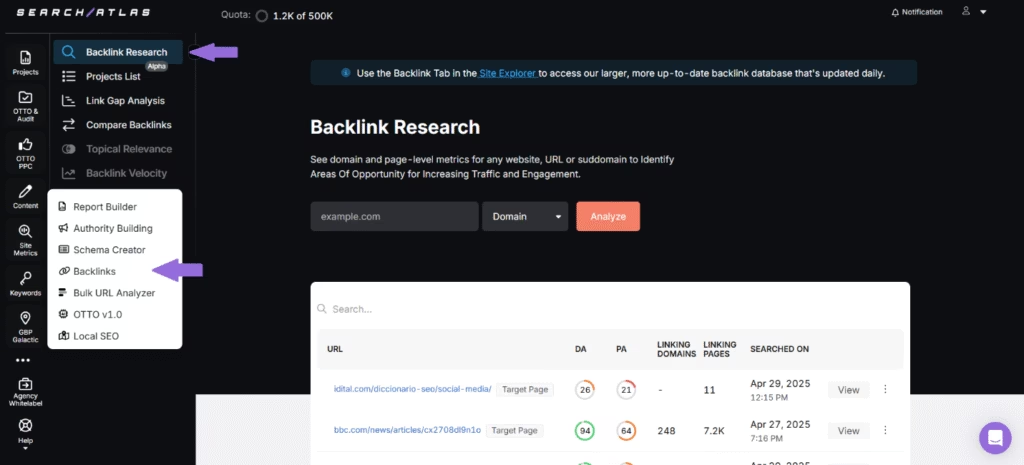
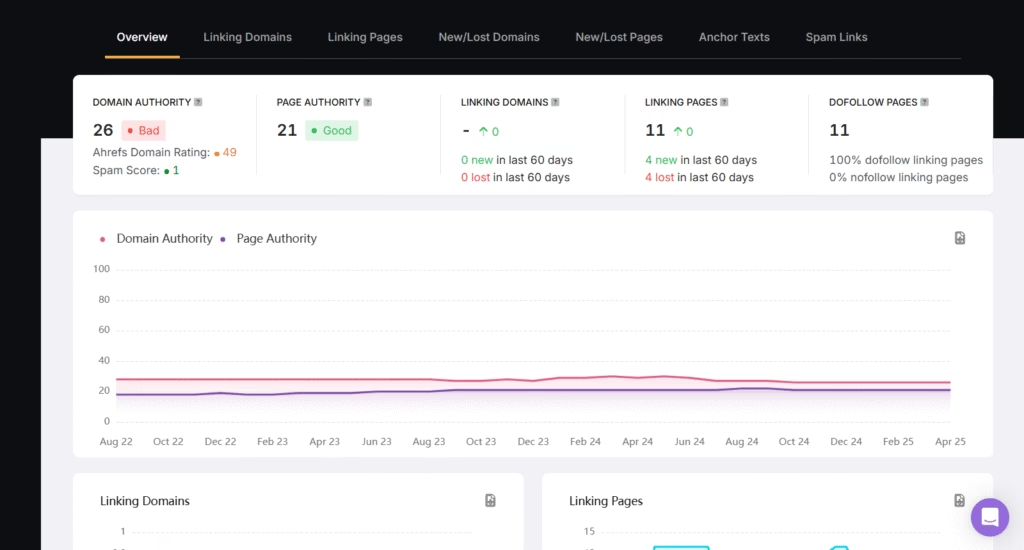
Improving the backlink strategy is achievable but requires dedication, patience, and a commitment to ethical link-building practices. The common tactics to boost backlinks are guest posting on reputable blogs, creating link-worthy content (such as infographics, research studies, or in-depth guides), conducting digital PR campaigns, and building relationships within your industry. Earning better backlinks helps improve your site’s authority, visibility, and rankings, making this a critical and attainable SEO goal.
4. Boost Local Visibility
Boosting local visibility refers to increasing a business’s presence in local search results, especially for users searching for products or services in a specific geographic area. Boosting local visibility is crucial for brick-and-mortar businesses, service providers, and franchises that rely on local customers. Improving local visibility involves optimizing your website and online listings (like Google Business Profile) so that your business appears prominently in location-based queries, such as “coffee shop near me” or “best dentist in [city].”
Local visibility improvements are measurable through tools such as the Search Atlas Local SEO Heatmap Tool. The Search Atlas Local SEO Heatmap Tool allows you to track organic visibility for local searches and shows where websites appear in the Google Map Pack for their target geographic locations.
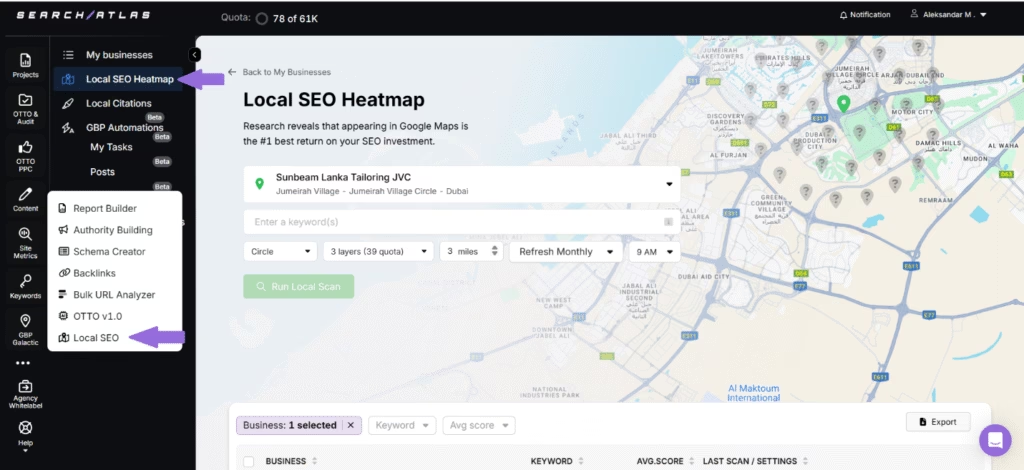
Boosting local visibility is highly achievable for most businesses, often showing results more quickly than traditional SEO efforts due to less competition in local markets compared to national searches. The strategies to improve local visibility are optimizing your Google Business Profile, guaranteeing NAP (Name, Address, Phone) consistency across all online directories, earning positive customer reviews, using local keywords in your content, and creating location-specific landing pages. With consistent effort and proper optimization, businesses can significantly increase their presence in local search results, attract more foot traffic, and drive more local leads and sales.
5. Improve Mobile Usability
Improving mobile usability refers to improving how well your website performs and appears on mobile devices. Search engines have shifted to mobile-first indexing with the increase in users browsing the web on mobile, meaning the mobile version of your site is considered the primary version for ranking and indexing. Improving mobile usability makes sure your site is responsive, loads quickly, has easy-to-read text, and offers a seamless user experience on smaller screens.
Mobile usability improvements are measurable through various analytical tools and performance metrics. Google’s PageSpeed Insights provides specific scores and recommendations for mobile optimization. Google Search Console offers a dedicated Mobile Usability report that identifies specific issues affecting your site’s mobile performance. Additionally, user behavior analytics through Google Analytics reveal mobile-specific metrics, including bounce rates, session duration, conversion rates, and page load times segmented by device type.
Improving mobile usability is completely achievable with the right approach. This approach includes using responsive web design, optimizing images and page load speed, simplifying navigation, and designing content layouts for smaller screens. Fixing usability issues improves the user experience, leads to better search rankings, reduces bounce rates, and increases engagement from mobile visitors.
6. Reduce Bounce Rate
Reducing bounce rate refers to the goal of lowering the percentage of visitors who land on your website and leave without interacting with any other page. A bounce occurs when a user lands on a webpage and exits without clicking on internal links, filling out forms, making purchases, or interacting with other elements on the site. Reducing the bounce rate means encouraging users to explore more pages, stay longer, and engage with your content, ultimately improving the chances of conversion.
Bounce rate reductions are measurable through tools such as Google Analytics. Google Analytics provides detailed bounce rate data segmented by traffic source, device type, geographic location, individual pages, and periods, allowing you to identify specific areas needing improvement. You can track bounce rates for organic search traffic specifically, comparing performance across different landing pages and monitoring changes over time.
Reducing the bounce rate is a realistic and achievable goal when you focus on delivering a better user experience. This includes increasing page load speed, creating more relevant and engaging content, using clear calls to action (CTAs), improving mobile usability, and guaranteeing intuitive navigation. By addressing user intent and aligning your content with what visitors are searching for, you can keep them on your site longer and guide them toward deeper engagement.
7. Enhance User Experience
Enhancing user experience (UX) refers to improving how users interact with and perceive your website during their visit. UX involves aspects like site speed, mobile responsiveness, intuitive design, accessibility, and clear messaging, all of which contribute to how users feel when using your site. A positive user experience means that visitors can easily navigate your site, find the information they need, trust the content, and enjoy a smooth, engaging journey from entry to conversion.
User experience improvements are measurable through a combination of quantitative analytics and qualitative feedback mechanisms. Google Analytics provides key UX metrics, including session duration, pages per session, bounce rate, and conversion rates, while core web vitals measure technical performance factors like loading speed, interactivity, and visual stability. Additionally, heat mapping software offers heat maps, scroll maps, and session recordings that reveal how users actually interact with your site.
Improving user experience is achievable with the right strategies and continuous optimization. Start by understanding user behavior through data and then make targeted improvements such as simplifying navigation, improving visual design, optimizing page load times, and guaranteeing mobile compatibility. Additionally, regular testing and feedback collection help identify friction points. When users have a seamless, enjoyable experience on your site, they are more likely to stay longer, return, and convert, making UX a key driver of long-term SEO and business success.
8. Strengthen Brand Awareness
Strengthening brand awareness refers to increasing the visibility and recognition of your brand among your target audience. In the context of SEO, strengthening brand awareness means making sure your brand appears consistently and prominently in search engine results when users look for relevant products, services, or industry information. Boosting brand awareness makes your business more familiar and trustworthy in the eyes of potential customers, often leading to higher click-through rates, better engagement, and repeat visits.
Brand awareness improvements through SEO are measurable using various metrics and analytical approaches. Tools like Google Search Console and Google Analytics can show branded search volume (how often people search for your brand name), impressions, direct traffic, and engagement metrics. Additionally, social listening tools, surveys, and tools like the Search Atlas Site Explorer Tool can track how frequently your brand is mentioned online, how it’s associated with specific keywords, and the sentiment surrounding those mentions.
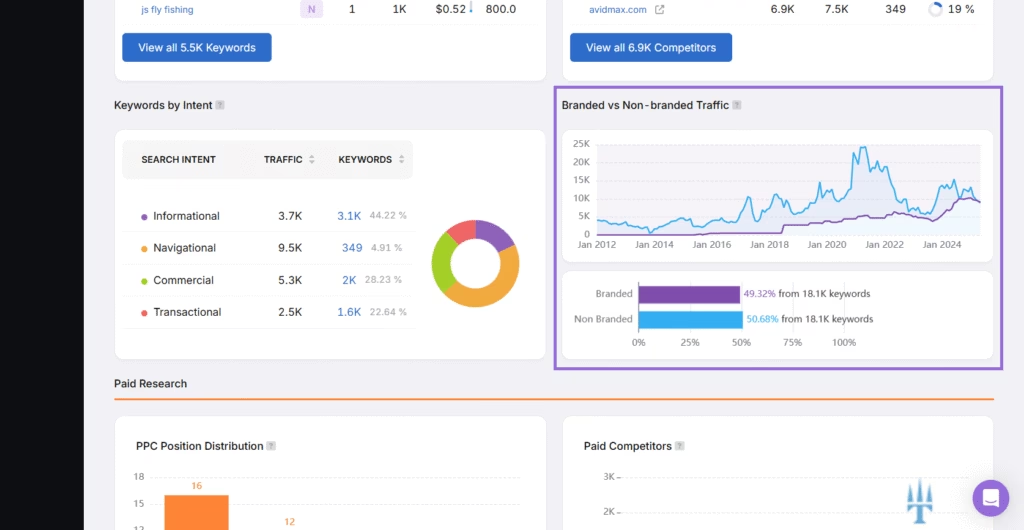
Strengthening brand awareness is achievable with a well-executed SEO strategy. Consistently publishing high-quality, keyword-optimized content, earning backlinks from authoritative sites, and maintaining a strong presence in search results can make your brand more visible to users at various stages of their buyer journey. Over time, this repeated exposure builds familiarity and trust, turning casual visitors into loyal followers and customers.
9. Optimize Engagement Rate
Optimizing engagement rate refers to the process of increasing how actively users interact with your website content. Engagement includes actions like clicking internal links, watching videos, sharing blog posts, submitting forms, leaving comments, or spending more time on a page. A high engagement rate indicates that visitors find your content valuable, relevant, and compelling, which boosts user satisfaction and signals quality to search engines, potentially improving your rankings.
Engagement rate improvements are measurable through tools like Google Analytics. Google Analytics provides detailed engagement metrics, including average session duration, pages per session, bounce rate, and scroll depth measurements that reveal how deeply users consume your content. Additionally, heat mapping tools visualize where users click, how far they scroll, and which content elements attract the most attention.
Optimizing the engagement rate is achievable with the right strategies. These strategies include creating interactive, well-structured, and user-focused content and improving page load speed, mobile usability, and site design. When visitors engage more with your content, they are more likely to stay longer, convert, and return, making this a powerful SEO goal for driving long-term results.
10. Increase Conversion Rates
Increasing conversion rates refers to the goal of getting more website visitors to complete a desired action, such as making a purchase, filling out a form, signing up for a newsletter, or booking a consultation. Increasing conversion rates focuses on attracting the right audience through organic search while making sure that once visitors arrive on your site, they are motivated and able to take meaningful actions. Conversion rate is a vital indicator of how effectively your website turns visitors into leads or customers.
Conversion rate improvements are measurable using tools like Google Analytics and Google Tag Manager. These tools track user actions on your site and allow you to set up goals or events (e.g., form submissions, button clicks, checkouts) to monitor conversions. You can calculate the conversion rate by dividing the number of conversions by the total number of visitors and multiplying by 100 to get a percentage. This calculation helps you understand how well your site is performing in terms of turning traffic into tangible results.
Increasing conversion rates is achievable with a combination of data analysis, content optimization, and user experience improvements. These improvements include writing persuasive, benefit-focused copy, using clear and visible calls to action (CTAs), building trust through social proof (like reviews and testimonials), improving page speed, and simplifying navigation and checkout processes. When SEO efforts are aligned with conversion optimization, you drive more traffic as well as make sure that traffic delivers real business value.
How to Set Smart SEO Goals and Objectives for Your Business?
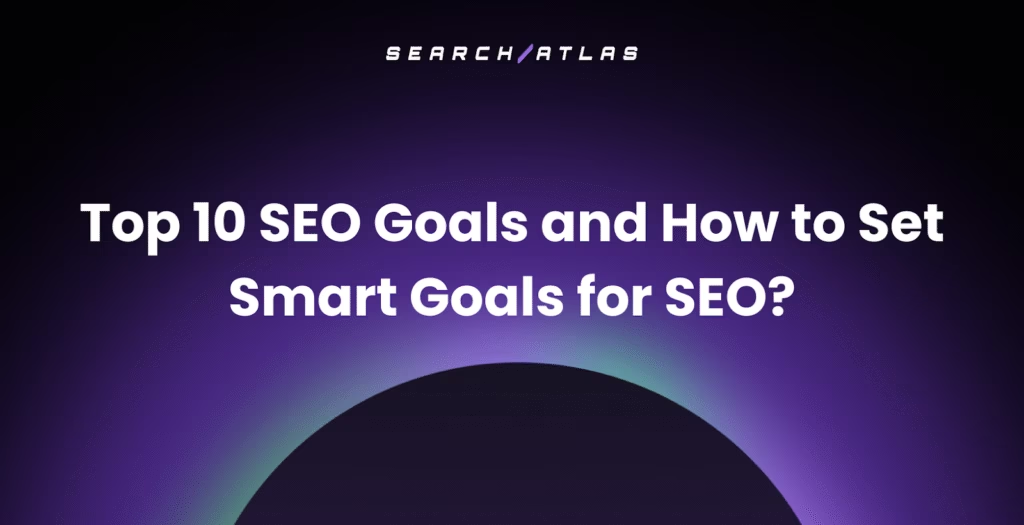
There are 6 steps to set smart SEO goals and objectives for your business. The 6 steps to set smart SEO goals and objectives for your business are reviewing your business objectives, conducting a comprehensive SEO audit, performing in-depth research, outlining your SEO goals, and regularly reviewing and adjusting your goals based on performance and insights.
1. Review Your Business Objectives
To set smart SEO goals and objectives for your business, start by revisiting your core business objectives, which are the strategic goals your company aims to achieve, such as increasing sales, expanding into new markets, or building brand authority. Your SEO goals should align with these overarching objectives to make sure that your search marketing efforts directly support business growth. For example, if your business wants to grow its e-commerce revenue, your basic SEO goals might focus on improving product page rankings and optimizing for high-converting keywords.
2. Conduct a Comprehensive SEO Audit
Assess your current SEO performance through a thorough SEO audit of your website’s technical health, content quality, backlink profile, and current rankings. Use tools like Google Analytics, Search Console, and the Search Atlas SEO Software Platform to establish baseline metrics for organic traffic, keyword rankings, conversion rates, and technical performance indicators. This baseline data is crucial for setting realistic SEO goals and measuring progress over time.
3. Do Your Research
Next, gather strategic insights by researching keywords, competitors, and audience behavior. Use tools like Google Keyword Planner or the Search Atlas Keyword Magic Tool to find high-volume, low-competition keywords. Analyze competitors to see what they are ranking for and where their backlinks come from. Additionally, study your audience to understand what they are searching for and how they interact with your content. This research makes sure your long-term SEO goals are targeted, relevant, and based on real data.
4. Outline Your SEO Goals
After completing your audit and research, start outlining your SEO goals. The SEO SMART goals examples are listed below.
- Increase organic traffic by 30% in 6 months.
- Improve page load speed to under 2 seconds.
- Acquire 50 high-quality backlinks in 3 months.
Apply the SMART framework to make sure your goals are easier to track, manage, and align with your broader business objectives. Prioritize the goals based on available resources and potential business impact to guarantee efficient use of time and effort. Additionally, break larger goals into smaller, manageable milestones to track progress more easily and maintain momentum.
5. Define Success Metrics and KPIs
Define clear success metrics and KPIs for each goal to measure progress effectively. Success metrics are the specific data points that indicate whether you are moving toward your objectives. For example, organic traffic growth, bounce rate reduction, or improvements in keyword rankings. KPIs are measurable values tied directly to your goals, such as the number of new backlinks acquired, the average session duration, or the conversion rate from organic search.
These indicators help you track performance over time, identify what is working, and adjust your strategy as needed. Consistently monitoring your KPIs helps you guarantee accountability and gain valuable insights that drive informed decision-making and long-term SEO success.
6. Regularly Review and Adjust Your SEO Goals
Set regular intervals, monthly or quarterly, to evaluate your progress using your defined KPIs. Revisit your strategy and make necessary adjustments if certain tactics are not delivering the expected results. You might need to shift focus from one goal to another, refine your keyword targets, or invest more in technical SEO or content creation. This continuous review process helps you stay agile, maximize performance, and make sure your SEO efforts consistently support your overall business growth.
What Makes a Good SEO Goal?
A good SEO goal must directly support your broader business objectives rather than existing as an isolated metric. A good SEO goal should connect search engine optimization efforts to tangible business outcomes such as revenue growth, lead generation, customer acquisition, or brand awareness expansion. For example, instead of simply aiming to “increase organic traffic,” a good SEO goal would be to “increase organic traffic to product pages by 35% to generate 50 additional qualified leads per month.” This alignment makes sure that SEO investments contribute meaningfully to business success and makes it easier to justify resources and budget allocation for optimization efforts.
Additionally, a strategic SEO goal must follow the SMART framework, making sure it is clearly defined, realistic, and aligned with your business strategy. The SMART framework for a good SEO goal is outlined below.
- Specific. Clearly define what you want to achieve (e.g., increase organic traffic, and reduce bounce rate).
- Measurable. Includes metrics or KPIs to track progress and success.
- Achievable. Realistic based on your resources, timeline, and capabilities.
- Relevant. Aligned with broader business goals and SEO strategy.
- Time-bound. Has a clear deadline or time frame for achieving the goal.
These five elements make sure your SEO priorities are well-structured and effective. Making your goals SMART helps you set a solid foundation for planning, execution, and long-term success in your search engine optimization plan.
What Makes Enterprise SEO Goals Unique?
Enterprise SEO goals are unique because they are designed to support large-scale websites, complex organizational structures, and broader business objectives. Enterprise SEO goals are typically aligned with long-term, strategic business objectives, such as global brand visibility, lead generation across multiple markets, or dominating competitive search landscapes. Robust enterprise SEO goals often require deeper collaboration with C-level executives and a data-driven approach to show ROI and business impact.
Effective enterprise SEO goals must consider how to optimize and track performance across thousands of pages or multiple websites, requiring detailed planning and sophisticated tools. Strong enterprise SEO goals demand cross-functional coordination, as execution typically involves collaboration between several departments, making alignment and communication essential.
Well-defined enterprise SEO goals emphasize data-driven decision-making and measurable ROI. Strategic enterprise SEO goals often involve more rigorous KPI tracking and require regular reporting to demonstrate the impact on revenue, market share, or customer acquisition. Additionally, comprehensive enterprise SEO goals must address international SEO strategies, including hreflang implementation, geo-targeting, and localization, since many enterprise-level businesses operate in multiple countries and languages.
What to Know About SEO Goals Besides SEO Benefits?
SEO goals are clear, strategic objectives set to guide and measure the effectiveness of your SEO efforts. SEO goals can include targets like increasing organic search traffic by a certain percentage, ranking higher for specific keywords, improving site speed, or reducing bounce rates.
SEO benefits, on the other hand, are the positive results that come from executing and achieving SEO goals. The main SEO benefits are increased website visibility in search engines, higher organic traffic, better user experience, greater brand credibility, and ultimately, more leads and conversions. These outcomes contribute to long-term business growth and digital success.
SEO goals and SEO benefits go hand in hand. SEO goals set the direction, while SEO benefits reflect the value gained from reaching them.
What is the Difference Between SEO Goals and SEO Strategy?
The difference between SEO goals and SEO strategy is that SEO goals define what you want to achieve, while SEO strategy outlines how you plan to achieve those goals.
SEO goals are specific, measurable outcomes you aim to accomplish through your SEO efforts. The main purpose of SEO goals is to give direction to your optimization work and align it with your overall business objectives.
SEO strategy, by contrast, is the overall plan you follow to reach your SEO goals. SEO strategy includes the methods and tactics you use, such as keyword research, content creation, on-page optimization, and link-building. The main goal of an SEO strategy is to provide a roadmap or action plan that guides all SEO efforts toward achieving the defined goals. For example, if your SEO goal is to increase organic traffic, your strategy might include optimizing existing content, publishing new keyword-targeted blog posts, improving internal linking, and increasing site speed.
What is the Difference Between SEO Goals and SEO Campaigns?
The difference between SEO goals and SEO campaigns is that SEO goals define what you want to achieve, while SEO campaigns are the organized efforts or actions taken to reach those goals.
SEO goals are measurable, strategic objectives that help guide your overall search engine optimization efforts. SEO goals are meant to align with broader business priorities and serve as benchmarks for success. The main purpose of SEO goals is to provide a clear direction and focus for your SEO strategy.
SEO campaigns, by contrast, are structured and time-limited initiatives designed to accomplish those SEO goals. SEO campaigns typically involve executing specific tactics such as publishing keyword-rich content, conducting technical audits, earning backlinks, or optimizing existing pages. The goal of an SEO campaign is to implement and coordinate efforts that contribute directly to meeting your predefined SEO goals. For instance, you might launch a three-month content marketing campaign that includes publishing 20 new blog posts targeting high-volume keywords to help increase your site’s organic traffic.
Can SEO Goals Align With SEO KPIs?
Yes, SEO goals can align with SEO KPIs. In fact, aligning SEO goals with SEO KPIs is essential for tracking progress and measuring success effectively.
SEO goals define what you want to achieve, while SEO KPIs provide the specific metrics used to measure progress toward those goals. For example, if your SEO goal is to boost organic traffic, a relevant SEO KPI could be the number of organic sessions per month. If your goal is to improve user experience, KPIs might include average session duration or pages per session. Aligning your SEO goals and KPIs helps you make sure that your SEO efforts are focused and data-driven, allowing you to monitor performance, make informed adjustments, and demonstrate ROI.







